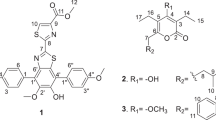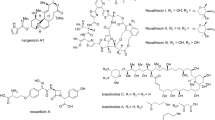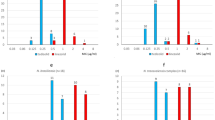Abstract
Nocardithiocin is a novel thiopeptide compound produced by the pathogenic Nocardia pseudobrasiliensis strain IFM 0757. It shows a strong activity against acid-fast bacilli such as the Mycobacterium and Gordonia species. Nocardithiocin was highly active against rifampicin-resistant as well as -sensitive Mycobacterium tuberculosis strains, and most of the resistant strains were inhibited at concentrations ranging from 0.025 to 1.56 μg ml−1. The structure of the thiopeptide antibiotic containing thiazole, natural and unnatural amino acids was elucidated by MS and NMR spectral analyses.
Similar content being viewed by others
Log in or create a free account to read this content
Gain free access to this article, as well as selected content from this journal and more on nature.com
or
References
Bérdy, J. Bioactive microbial metabolites: a personal view. J. Antibiot. 58, 1–26 (2005).
Beaman, B. L. & Beaman, L. Nocardia species: host-parasite relationships. Clin. Microbiol. Rev. 7, 213–264 (1994).
Kageyama, A. et al. Nocardial infections in Japan from 1992 to 2001, including the first report of infection by Nocardia transvalensis. Eur. J. Epidemiol. 19, 383–389 (2004).
Tsuda, M. et al. Brasilibactin A, a cytotoxic compound from actinomycete Nocardia brasiliensis. J. Nat. Prod. 68, 462–464 (2005).
Komatsu, K., Tsuda, M., Tanaka, Y., Mikami, Y. & Kobayashi, J. SAR studies of brasilicardin A for immunosuppressive and cytotoxic activities. Bioorg. Med. Chem. 13, 1507–1513 (2005).
Bagley, M. C., Dale, J. W., Merritt, E. A. & Xiong, X. Thiopeptide antibiotics. Chem. Rev. 105, 685–714 (2005).
Holmes, D. J., Caso, J. L. & Thompson, C. J. Autogenous transcriptional activation of a thiostrepton-induced gene in Streptomyces lividans. EMBO J. 12, 3183–3191 (1993).
Mai, T. et al. Productivity of antimicrobial substances in pathogenic actinomycetes Nocardia brasiliensis. Microbiol. Cult. Coll. 13, 103–108 (1997).
Yun, B. S. & Seto, H. Promoinducin, a novel thiopeptide produced by Streptomyces sp. SF2741. Biosci. Biotechnol. Biochem. 59, 876–880 (1995).
Leet, J. E. et al. Nocathiacins, new thiazolyl peptide antibiotics from Nocardia sp. II. Isolation, characterization, and structure determination. J. Antibiot. 56, 232–242 (2003).
Rodríguez, J. C., Holgado, G. G., Sánchez, R. I. S. & Cañedo, L. M. Radamycin, a novel thiopeptide produced by Streptomyces sp. RSP9. II. Physico-chemical properties and structure determination. J. Antibiot. 55, 391–395 (2002).
Muramatsu, I., Motoki, Y., Aoyama, M. & Suzuki, H. Amino acids and derivatives of thiazole-4-carboxylic acid as constituents of thiopeptin B. J. Antibiot. 30, 383–387 (1977).
Fujii, K. et al. A nonempirical method using LC/MS for determination of the absolute configuration of constituent amino acids in a peptide: elucidation of limitations of Marfey's method and of its separation mechanism. Anal. Chem. 69, 3346–3352 (1997).
Fujii, K., Ikai, Y., Oka, H., Suzuki, M. & Harada, K.-I. A nonempirical method using LC/MS for determination of the absolute configuration of constituent amino acids in a peptide: combination of Marfey's method with mass spectrometry and its practical application. Anal. Chem. 69, 5146–5151 (1997).
Fujii, K. et al. Simultaneous detection and determination of the absolute configuration of thiazole-containing amino acids in a peptide. Tetrahedron 58, 6873–6879 (2002).
Harada, K.-I. et al. Application of D, L-FDLA derivatization to determination of absolute configuration of constituent amino acids in peptide by advanced Marfey’s method. Tetrahedron Lett. 37, 3001–3004 (1996).
Tanaka, Y., Gräfe, U., Yazawa, K., Mikami, Y. & Ritzau, M. Nocardicyclins A and B: new anthracycline antibiotics produced by Nocardia psedobrasiliensis. J. Antibiot. 50, 822–827 (1997).
Tsuda, M. et al. Nocaracins A-C, and brasiliquinone D, new metabolites from the actinomycete Nocardia brasiliensis. J. Nat. Prod. 62, 1640–1642 (1999).
Nemoto, A. et al. Asterobactins, a new siderophore group antibiotic from Nocardia asteroides. J. Antibiot. 55, 593–597 (2002).
Kaneda, S. et al. Biological activities of newly prepared saframycins. J Antibiot. 40, 1640–1642 (1987).
Acknowledgements
This work was partially supported by a Grant from Daiichi Pharmaceutical Co. (presently Daiichi-Sankyo Pharmaceutical Co.) Ltd, Chiba, Japan.
Author information
Authors and Affiliations
Corresponding author
Rights and permissions
About this article
Cite this article
Mukai, A., Fukai, T., Hoshino, Y. et al. Nocardithiocin, a novel thiopeptide antibiotic, produced by pathogenic Nocardia pseudobrasiliensis IFM 0757. J Antibiot 62, 613–619 (2009). https://doi.org/10.1038/ja.2009.90
Received:
Revised:
Accepted:
Published:
Issue date:
DOI: https://doi.org/10.1038/ja.2009.90
Keywords
This article is cited by
-
Geninthiocins E and F, two new cyclic thiopeptides with antiviral activities from soil-derived Streptomyces sp. CPCC 200267 using OSMAC strategy
The Journal of Antibiotics (2023)
-
Anti-mycobacterial activity of heat and pH stable high molecular weight protein(s) secreted by a bacterial laboratory contaminant
Microbial Cell Factories (2022)
-
Characterization of anti-BCG benz[α]anthraquinones and new siderophores from a Xinjiang desert–isolated rare actinomycete Nocardia sp. XJ31
Applied Microbiology and Biotechnology (2020)
-
Therapeutic agents from endophytes harbored in Asian medicinal plants
Phytochemistry Reviews (2020)
-
Characterization of Nocardithiocin Derivatives Produced by Amino Acid Substitution of Precursor Peptide notG
International Journal of Peptide Research and Therapeutics (2020)



